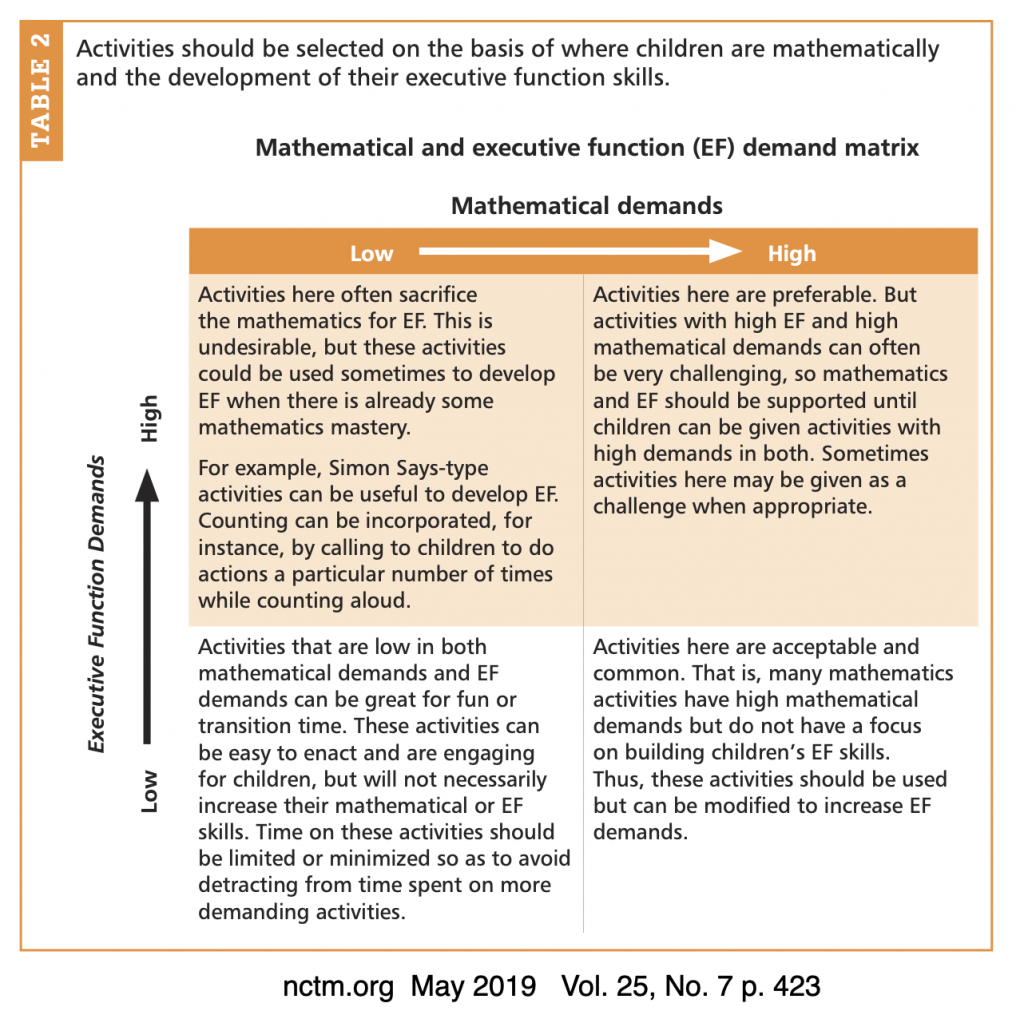Resources mentioned in this episode:
Double Impact: Mathematics and Executive Function by Candace Joswick, Douglas H. Clements, Julie Sarama, Holland W. Banse, and Crystal A. Day-Hess
Welcome fellow Recovering Traditionalists to Episode 39. Today we take a look at Executive Function’s Impact on Mathematics.
In honor of the last edition of the journal Teaching Children’s Mathematics by NCTM I thought I’d highlight an article from that last edition. Now, don’t worry if you are a member of NCTM there is still going to be a journal but it is a combined journal for all grades PreK-12.
In this last edition of TCM, there is an article that non-members can read for free called Double Impact: Mathematics and Executive Function by Candace Joswick, Douglas H. Clements, Julie Sarama, Holland W. Banse, and Crystal A. Day-Hess.
In the first part of the article they talk the impact Executive Function (EF) processes have on Mathematics and the three categories of EF:
- Inhibitory control – not acting impulsively
- Working memory – hold info short term and process or apply that information
- Attention shifting and cognitive flexibility – ability to shift attention as needed and dig for a different strategy if the first one doesn’t work
The article goes on to show how to modify activities so that students can be working on both Mathematics and Executive Functions at the same time.
On page 423 they share the Mathematical and executive function (EF) demand matrix,

On page 423 they discuss how to design for optimal learning and problem solving using this matrix.
“Asking young children to face high mathematical demands and high EF demands may be overwhelming and inappropriate. So, what is best? To begin, very low mathematics demands are usually undesirable—the mathematics should not be sacrificed for high EF demands unless the activity goal is EF training only, and activities with both low EF and low mathematical demands should be used cautiously (see table 2). If they are necessary for some children, those children should subsequently receive additional experiences that slowly but surely increase the demands so they build both competencies, catching up to their peers.
Activities with moderate to high mathematical demands that do not explicitly or intentionally support or demand the use of EF processes are, of course, useful (see table 2). If incorporating moderate to high EF demands into activities with high mathematical demands proves too difficult for students, some folding back to lower EF or mathematical demands is appropriate before returning to higher demands. Ultimately, activities with both high EF and mathematics demands are most desirable, but not all children can nor should start there or always be there. Some lowering of either EF or mathematical demands allows for the other area to be emphasized and for some direct instruction or support on EF or mathematics as necessary.”
As I read this, a light bulb came on about why some students are struggling with this new way we are teaching math. If you have kids who are struggling with some of these Executive Functions and then you ask them to do those things while also doing something that has high mathematical demand, they are going to struggle. For example, if students have not worked to develop their cognitive flexibility and then we give them a problem that requires them to do multiple attempts to solve the problem and it also requires some mathematical understandings that aren’t fully developed, they are just going to shut down.
So, as you design or use tasks in your classroom, this article made me realize that we also need to pay attention to the Executive Function demands that the task is placing on them as well.
Now remember with all of these episodes I don’t go deep into the book or article because if this is an area you want to learn more about, then I want you to go learn it straight from the source. We are all different learners and teachers and what I take away from a book or article might be different than what you take away. So if you want to learn more about how Executive Function impacts mathematics and how to modify tasks to include more executive function work, then this article is for you.
If you like what you have been hearing there are a few ways I would love for you to let me know. The first way is to subscribe to the podcast. If you are listening in iTunes make sure to hit that subscribe button. Also in iTunes I would love for you to leave a review and let me know if you are enjoying the podcast which types of episodes are your favorite. Really just anything to get me feedback about the show and lastly if you are on Instagram or Twitter I would love for you to share when you listen to an episode that you love. Make sure you tag me @buildmathminds and all of those are the ways to let me know that there are actually people out there listening. Thank you so much for letting me a small part of your math journey.
Subscribe and Review in iTunes
Hey, are you subscribed to the Build Math Minds Podcast, yet? If you’re not, make sure to do that today because I don’t want you to miss any episodes! Click here to subscribe to the podcast in iTunes.
While you’re there, don’t forget to leave a review on iTunes too. I would love to know your thoughts and how we can make sure that we give you content that you will really enjoy.
To leave a review, head over to iTunes and click on “Ratings and Reviews” and “Write a Review.” I can’t wait to hear your thoughts about the podcast.





Thank you for your posts!! They have have been very helpful to me in my homeschool!
Thank you! This was very informative. I am really appreciating your Podcast!
I’m not sure if you can just split up ” EF Skills” versus “math skills” like this. Not a lot of time to get into it, but there is a lot of research in this field that suggests you can’t just teach “EF skills” separate from the task specific item you may be doing. Hence if a student struggles with EF, you really have to coach that in the context of the subject you are teaching – which usually means the student has to know the content your teaching fairly well in order to even apply “EF skills” properly with the task at hand..